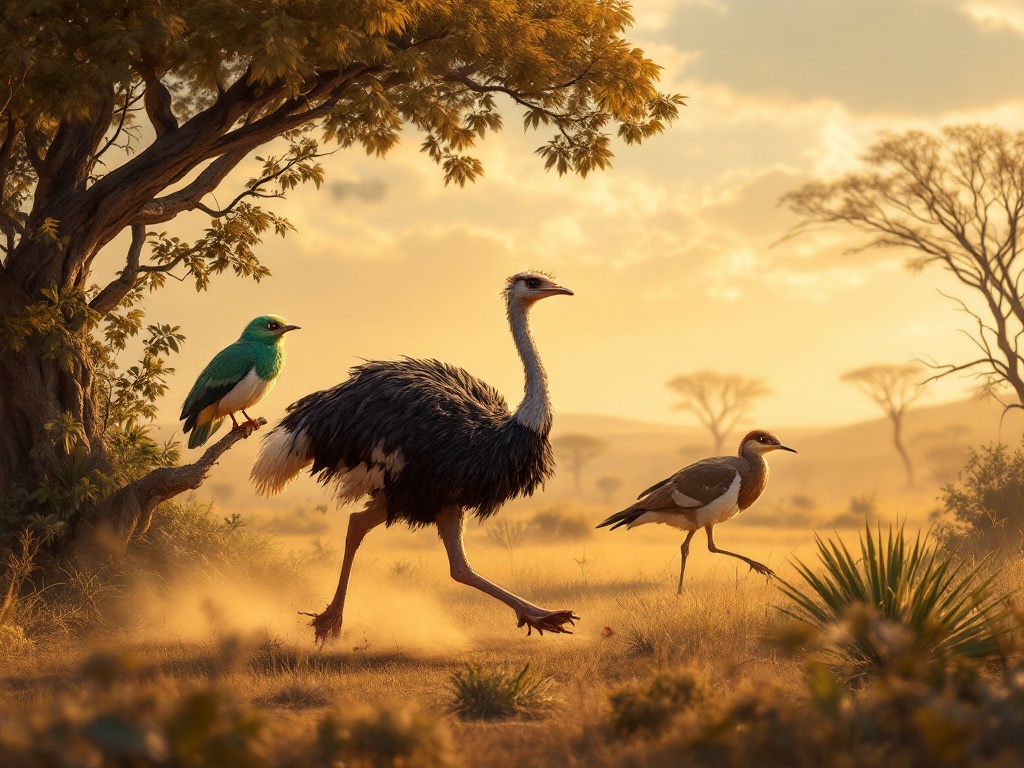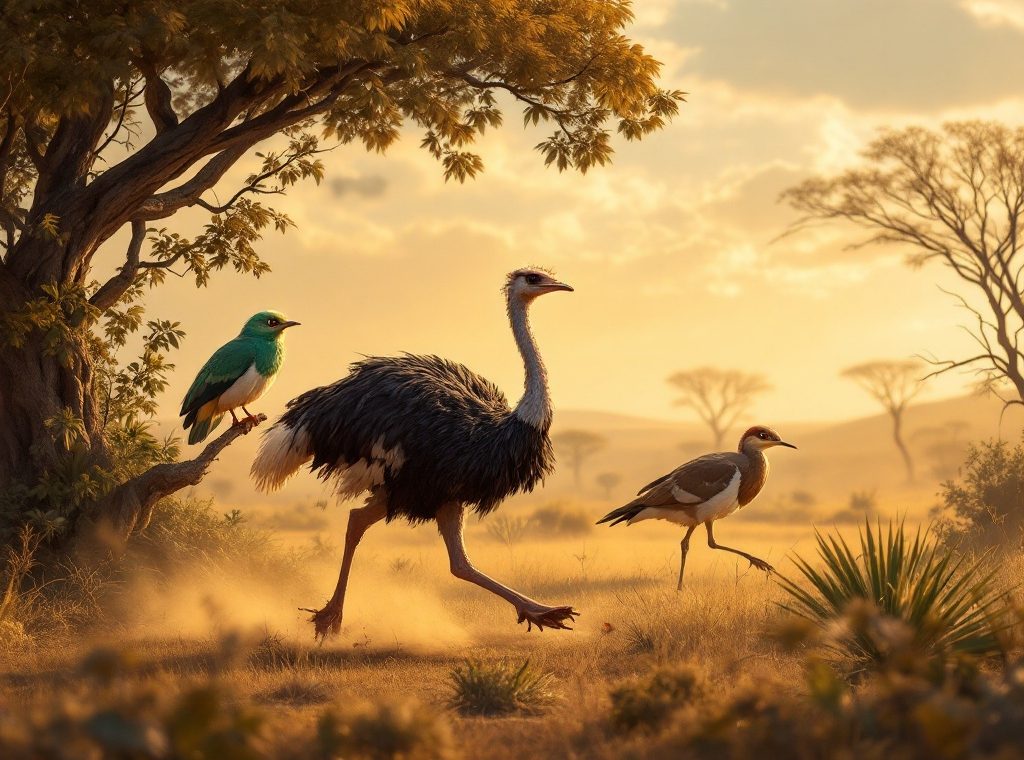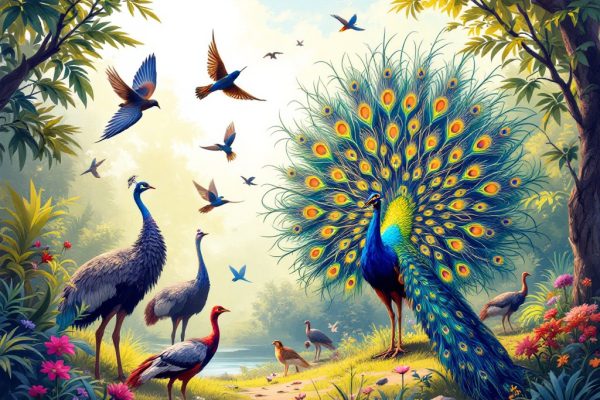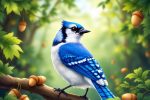Flightless Birds List: Discover These Interesting Animals
Discover the fascinating world of flightless birds, from the towering ostrich to the tiny Inaccessible Island rail. These unique creatures, representing around 60 species today, have evolved remarkable adaptations for survival without flight, showcasing powerful legs for running or swimming and specialized senses. Sadly, many face significant threats, including habitat loss and introduced predators. Explore their incredible stories, from the critically endangered kakapo to the rediscovered takahe, and learn how conservation efforts are crucial for their survival. Delve into the intriguing world of flightless birds and discover why their future depends on our actions.
Important information

- Around 60 flightless bird species exist today, a stark contrast to the 166 species already extinct.
- Flightlessness is an evolutionary adaptation often linked to environmental factors like lack of predators or abundant ground food.
- Habitat loss, introduced predators (like rats and cats), and climate change are major threats to flightless bird survival.
- Conservation efforts focus on habitat restoration, predator control, and captive breeding programs, with some success stories like the Kakapo Recovery Programme.
- Famous examples of flightless birds include the ostrich (largest living), kiwi (New Zealand’s icon), emperor penguin (adapted for aquatic life), and kakapo (critically endangered parrot).
Introduction to Flightless Birds
Flightless birds, numbering around 60 species today, represent a small fraction compared to their flying counterparts. This number is significantly lower than the approximately 166 flightless bird species already extinct. The loss of flight is an evolutionary adaptation, frequently influenced by environmental factors such as the absence of predators or a rich supply of ground-based food sources. As a result, flightless birds like ostriches, emus, and penguins have evolved strong legs adapted for running or swimming. Sadly, many of these unique birds are currently facing substantial threats to their survival.
Unique Characteristics of Flightless Birds
Flightless birds exhibit remarkable adaptations for survival without flight. Their wings have reduced in size over generations, while their legs have become stronger, allowing them to walk and run efficiently. Many flightless birds, such as ostriches and emus, have evolved to become impressively large. Island habitats, often lacking predators, contribute to flightlessness by enabling these birds to allocate energy towards developing other skills. Some become fast runners, while others become proficient swimmers. The kiwi, for example, has developed enhanced senses of smell and touch to find food. Penguins, with their flipper-like wings, provide another compelling example, using these modified limbs for swimming and maintaining body temperature. A defining characteristic of flightless birds is the lack of a keel bone, the anchor point for flight muscles found in their flying relatives.
Adaptations and Evolution
Flightless birds exhibit fascinating adaptations to their surroundings. Emperor penguins developed flippers for underwater propulsion, enabling them to navigate the ocean depths with remarkable agility. Ostriches evolved powerful legs for swift running, allowing them to traverse open grasslands at impressive speeds. Kiwis, with limited vision, rely on a heightened sense of smell to locate food in the dark underbrush of their forest habitats. These diverse adaptations highlight the unique challenges and evolutionary solutions found in various ecological niches.
Convergent Evolution and Flightlessness
Flightless birds offer a compelling example of convergent evolution, where unrelated species develop similar traits in similar environments. Ostriches in Africa, rheas in South America, and emus in Australia, despite their geographical separation, share striking similarities. These large birds are all flightless, with powerful legs built for speed and reduced wings. This remarkable convergence stems from shared environmental pressures. With fewer aerial predators and plentiful ground-level food sources, these birds independently evolved similar adaptations. Their flightlessness showcases the power of the environment to shape evolution, demonstrating how similar selective pressures can lead to analogous outcomes even in distantly related species. Ostriches, rheas, and emus, exemplify this phenomenon.
Ostriches (Africa)
Known for their immense size, ostriches are the largest living birds. They possess strong legs adapted for running at high speeds, reaching up to 45 mph (72 km/h). Their wings, though small, play a role in balance and mating displays.
Rheas (South America)
Rheas, smaller than ostriches, are still impressive runners. They feature three toes on each foot, unlike the two-toed ostriches. Their feathers, unlike most flight birds, lack a hooked structure, making them appear shaggy.
Emus (Australia)
Emus are the second-largest living birds by height, after ostriches. They have specialized feathers that provide insulation, crucial for surviving the varying Australian climate. Their powerful legs enable them to cover vast distances in search of food and water.
Shared Adaptations
Despite their geographical isolation, these birds share key adaptations: flightlessness, strong legs, reduced wings, and an adaptation to ground-based living. This demonstrates the strength of convergent evolution in response to similar environmental pressures.
Ground-Dwelling and Isolation
Many flightless birds thrive on land, particularly on isolated islands. This isolation often means a lack of flying predators, removing the need for these birds to fly. Consequently, they adapt to terrestrial life, developing strong legs for running. Here are a few prime examples:
Inaccessible Island Rail
This small, flightless bird lives predator-free on its namesake island in the Tristan da Cunha archipelago.
Flightless Cormorant
A skilled swimmer found in the Galapagos Islands, this bird has entirely abandoned flight.
Island isolation and the absence of predators drive these evolutionary changes, often resulting in the loss of flight.
List of Notable Flightless Birds
Flightless birds display remarkable diversity across the globe. The largest, the common ostrich, roams Africa, while the tiny Inaccessible Island rail calls the remote Inaccessible Island in the Tristan da Cunha archipelago home. New Zealand, a sanctuary for unique birdlife, shelters the kakapo, a critically endangered, nocturnal, flightless parrot. New Zealand is also home to the kiwi, its national symbol. The kiwi is a small, long-beaked, nocturnal bird, represented by five distinct species: Brown, Great Spotted, Little Spotted, Rowi, and Tokoeka.
The emperor penguin, the largest of its kind, thrives in the Antarctic. The takahe, a flightless rail once thought extinct but rediscovered in 1948, also resides in New Zealand.
Cassowaries, large flightless birds, inhabit the rainforests of New Guinea and northeastern Australia. Three species exist: Southern, Northern, and Dwarf. The flightless cormorant, found only in the Galapagos Islands, is another unique example.
In southernmost South America, the Fuegian steamer duck, a powerful swimmer, makes its home. High in the Andes, on Lake Titicaca, bordering Peru and Bolivia, lives the flightless Titicaca grebe.
Common Ostrich: The Largest Flightless Bird
Towering up to nine feet and weighing a hefty 350 pounds, the ostrich reigns as the world’s largest living flightless bird. Native to Africa, these impressive creatures are also incredibly swift, reaching speeds of up to 45 miles per hour, making them one of the fastest land animals.
Inaccessible Island Rail: The Smallest Flightless Bird
The Inaccessible Island rail, the world’s smallest flightless bird, thrives on Inaccessible Island. It is perfectly adapted to this unique environment.
Kakapo: Critically Endangered Nocturnal Parrot
The kakapo, a critically endangered, flightless parrot, is found only in New Zealand and roams the forests at night. Sadly, introduced predators such as cats and rats have decimated their population.
Emperor Penguin: Adapted for Aquatic Life
Emperor penguins are masters of the Antarctic. Their streamlined bodies and powerful flipper-like wings make them swift swimmers. These agile birds can dive to incredible depths, sometimes over 500 meters, holding their breath for extended periods. Dense, waterproof feathers provide crucial insulation in the extreme cold, showcasing their adaptation to this challenging environment.
Kiwi: New Zealand’s National Icon
The kiwi is a true icon of New Zealand, a small, flightless bird that has captured the nation’s heart. These nocturnal creatures, with their long beaks and hair-like feathers, are instantly recognizable. Kiwis are members of the ratite family, sharing ancestry with ostriches and emus. Remarkably, kiwis lay the largest egg relative to their body size of any bird. Unfortunately, all five kiwi species are currently classified as either endangered or vulnerable. Yet, their cultural significance to the Māori people remains strong, and their image graces New Zealand currency and stamps, solidifying their status as a national treasure.
Takahe: Rediscovered Species
Once believed extinct, the Takahe, a flightless bird native to New Zealand, was rediscovered in 1948. This remarkable comeback, after 50 years lost to the world, underscored the vital importance of conservation efforts and the protection of vulnerable species.
Cassowary: A Massive Forest Dweller
Cassowaries are large flightless birds inhabiting the rainforests of New Guinea and northeastern Australia. They are the world’s second-heaviest living bird species, surpassed only by the ostrich. Atop their heads sits a unique keratinous growth called a casque. Their diet consists primarily of fruit, but they also forage for other vegetation on the forest floor.
Flightless Cormorant: Unique Galapagos Resident
The Galapagos Islands are home to the flightless cormorant (Nannopterum harrisi), the only cormorant species unable to fly. This unique characteristic evolved due to the islands’ predator-free environment, which eliminated the need for escape by air.
Fuegian Steamer Duck: A Powerful Swimmer
The remarkably strong-swimming Fuegian steamer duck (Tachyeres pteneres) is flightless, using its wings like paddles to navigate the choppy waters around Tierra del Fuego and the Falkland Islands. This unique adaptation allows it to thrive in this challenging environment.
Titicaca Grebe: Endangered Lake Bird
The flightless Titicaca grebe, also known as the puna grebe, lives only on Lake Titicaca, high in the Andes Mountains. Sadly, this unique bird is endangered, facing threats such as entanglement and drowning in fishing nets.
Extinct and Endangered Flightless Birds
The dodo, a flightless bird found only on Mauritius, disappeared in the 17th century due to human activity and introduced predators. A similar fate befell the moa, nine species of flightless birds from New Zealand, hunted to extinction by Māori peoples. The great auk, a flightless North Atlantic seabird, also succumbed to hunting pressures in the 19th century.
Today, several other flightless birds face precarious futures. The kakapo, a critically endangered parrot from New Zealand, struggles against habitat loss and introduced predators. The takahe, another flightless New Zealand bird, is vulnerable due to habitat degradation and introduced predators. The Titicaca grebe, inhabiting South America’s Lake Titicaca, is endangered by habitat loss, pollution, and fishing nets.
Habitat loss, driven by deforestation, agriculture, and urbanization, poses a major threat to flightless bird populations worldwide. Introduced predators, such as rats, cats, and dogs, exacerbate the problem by preying on the birds, their eggs, and chicks. Climate change adds another layer of risk, creating a challenging landscape for these birds’ survival.
Extinct Species Overview
Approximately 166 flightless bird species are extinct. One example is the dodo, endemic to Mauritius, which went extinct in the late 17th century due to human activity and introduced species. Other flightless birds, such as New Zealand’s moa and the great auk, have also met a similar fate, representing a permanent loss to the planet’s biodiversity.
Endangered and Vulnerable Species
Many flightless bird species are at risk, with about half classified as endangered or vulnerable. Iconic examples, like the Kakapo, Takahe, and Titicaca Grebe, highlight the seriousness of these threats. Habitat loss and predation are the main reasons for their decline, along with other contributing factors. Conservation efforts are underway to protect these unique birds.
Impact of Habitat Loss and Predators
Flightless birds face severe challenges. Introduced predators, such as rats, cats, and dogs, pose a significant threat, targeting these ground-nesting birds and their eggs. Consequently, populations dwindle, increasing their vulnerability to extinction. Habitat loss drastically reduces their living space and breeding grounds, making survival a constant struggle. The kakapo, a flightless parrot, exemplifies this struggle, facing predation from introduced mammals that has decimated its numbers. Similarly, the cassowary, a large flightless bird inhabiting the rainforests of New Guinea and northeastern Australia, is endangered by habitat destruction, putting its survival at risk.
Conservation Efforts and Challenges
Flightless birds are particularly susceptible to threats such as habitat loss, invasive predators, and the escalating effects of climate change. Their inability to fly amplifies their vulnerability to these dangers. However, dedicated conservation efforts provide a glimmer of hope. These crucial programs concentrate on habitat restoration, predator control, and captive breeding. The Takahe’s resurgence and the ongoing Kakapo conservation initiatives underscore the significance of these protective measures.
Threats to Flightless Birds
Habitat loss significantly threatens many bird species. Introduced predators, such as rats and cats, prey on flightless birds, their eggs, and chicks, devastating populations. Climate change further compounds the problem by disrupting food sources and altering habitats. This combination of threats has led to a drastic decline in bird numbers, creating a dire situation. Ongoing conservation efforts provide a beacon of hope.
Conservation Programs and Success Stories
Flightless bird conservation programs employ several key strategies: habitat restoration, predator control, and captive breeding. The Kakapo Recovery Programme stands out as a successful model, boosting kakapo numbers through close monitoring and supplemental feeding. Other species, like the Takahe and Kiwi, also face threats from introduced predators and habitat loss, necessitating dedicated conservation efforts. Continued work is crucial for the long-term survival of these unique birds.
















